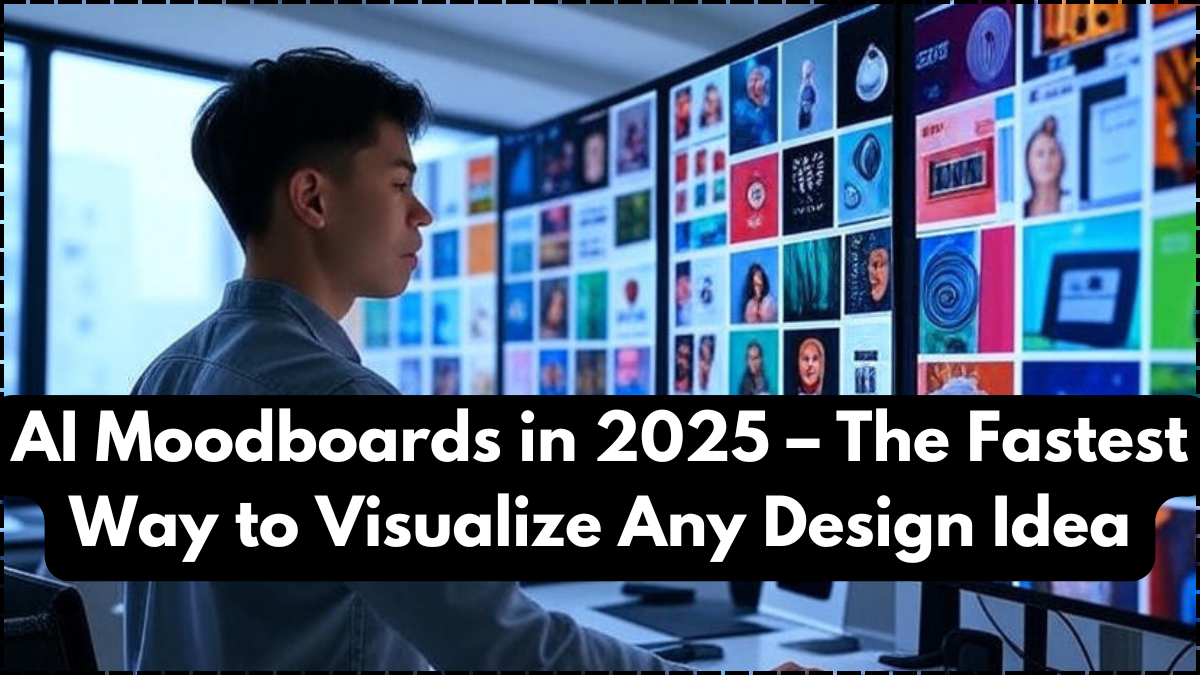Speed and clarity are two of the most important currencies in creative industries today. Whether you’re designing a home, a product, or a brand, being able to visualize a concept quickly has become essential. That’s where AI moodboards 2025 are changing the game. They allow designers to convert abstract ideas into coherent visual narratives in minutes, not hours.
Traditionally, building a moodboard meant manually gathering photos, color palettes, and typography samples—often taking hours or even days. But now, with the evolution of design visualization tools, AI can auto-generate personalized moodboards based on simple prompts, references, or keywords. It’s the fastest way to bridge the gap between inspiration and execution.

What Are AI Moodboards and How Do They Work?
AI moodboards 2025 are smart digital canvases generated using artificial intelligence. These platforms pull images, styles, layouts, colors, and typography from large design databases, then curate a board tailored to the user’s creative prompt. Think of it as having a personal design assistant that instantly understands your aesthetic needs.
Here’s what makes them revolutionary:
-
AI analyzes your design brief or keyword input
-
It selects matching visuals, layouts, colors, and mood references
-
Moodboards are editable, expandable, and exportable in multiple formats
-
Some platforms integrate with prototyping and 3D tools
With these design visualization tools, you’re no longer starting from scratch—you’re starting with style-aligned clarity.
Benefits of Using AI Moodboards in 2025
Whether you’re a designer, marketer, architect, or entrepreneur, AI moodboards 2025 save time, reduce creative block, and boost alignment with clients or collaborators.
| Benefit | Impact |
|---|---|
| Speed | Reduces moodboard creation time from hours to minutes |
| Personalization | Adjusts results based on style, tone, or industry |
| Consistency | Maintains brand or visual direction across projects |
| Client Communication | Offers a clear, fast visual reference for approvals |
| Integration | Syncs with Figma, Canva, Adobe Suite, and 3D apps |
These design visualization tools are becoming must-haves in creative workflows—especially for agencies, freelancers, and students working under tight deadlines.
Leading Platforms Offering AI Moodboards in 2025
Several tools now dominate the AI-powered moodboarding space. While some are general-use, others are industry-specific. All of them aim to simplify and enhance the visual storytelling process.
Notable platforms for AI moodboards 2025 include:
-
Milanote AI – Great for collaborative moodboarding in teams
-
Canva Visual AI – Ideal for social media branding and content creators
-
InteriorAI – Perfect for interior designers needing visual scene suggestions
-
Designify Studio – A go-to for product design and packaging mockups
-
Fabrie – A fusion of board creation and CAD integration
These design visualization tools not only inspire—they actually accelerate execution by helping designers move quickly from idea to prototype.
Who Should Be Using AI Moodboards Now?
AI moodboards 2025 aren’t limited to professional designers. Their ease of use and speed have made them valuable across sectors.
Best suited for:
-
Freelancers building brand kits, websites, or creative decks
-
Interior designers presenting quick client concepts
-
Marketers creating brand pitches or campaign visuals
-
Product teams visualizing UX/UI design directions
-
Startup founders shaping their MVP’s design language
In fact, many design schools have already started teaching these design visualization tools as part of their foundational workflows.
Conclusion: Creativity Powered by Speed and Precision
The future of visual storytelling is intelligent, fast, and hyper-personalized. AI moodboards 2025 reflect that shift, helping creatives work more efficiently and communicate more clearly. By reducing manual labor and guesswork, these tools give designers more time to refine their ideas and less time stressing over where to start.
Thanks to advanced design visualization tools, what once took days now takes minutes. And as the creative world moves faster, staying ahead means working smarter. With AI moodboarding, the future of design isn’t just beautiful—it’s instant.
FAQs
What are AI moodboards 2025?
They are AI-generated visual boards that automatically compile images, colors, fonts, and layouts based on your design input or brief.
How do design visualization tools help professionals?
They reduce the time needed to gather references, improve client alignment, and offer clearer creative direction from the start of a project.
Can I edit the moodboard once AI generates it?
Yes, most platforms allow you to rearrange, replace, or refine elements after generation to fit your exact vision.
Are AI moodboards only for designers?
Not at all. They’re also useful for marketers, business founders, architects, and content creators who need fast visual concepts.
Do these tools integrate with design software?
Yes. Leading design visualization tools now sync with Figma, Canva, Photoshop, and even 3D modeling platforms for seamless workflows.
Click here to learn more